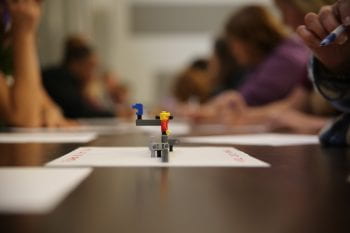More than 100 years before the invention of the modern computer, the idea of computer programming existed. Created by a gifted mathematician named Ada Lovelace who wrote instructions for the first computer program in the mid-1800s.
“The takeaway from her work is that computational thinking is not device-dependent,” said Jaime Gilligan, instructional specialist with the Institute for School Partnership at Washington University in St. Louis, and featured speaker at an October STEM Leadership Series workshop focusing on coding and computer science integration in schools.
“When we think about bringing computer science to our schools, we assume we need a computer first. But in fact, there are many ways to learn fundamental computing concepts without a computer, just simply using off-screen activities,” she said.

One such unplugged coding activity at the leadership series ended up being an “aha moment” for many of the educators in attendance. On the center of a long table was a completed LEGO model. The participants were tasked with creating written instructions for their fellow educators to follow in order to replicate the build.
“I was really stumped,” admitted Brandice Huling, a K-3 math teacher at Confluence Academy-Old North. “To experience the struggle of following coding done by another person, it gave me perspective and how you have to be very specific and not make any assumptions.”
Huling’s partner couldn’t understand her confusion, sure that she had written clear directions. But Huling explained she was interpreting it differently.
“When I saw the finished model the directions still didn’t make sense to me,” Huling said with a chuckle. “But it was an enlightening moment as far as how specific you have to be when you’re coding.”
One of the messages that Gilligan kept emphasizing was that opportunities for computer science should be easily accessible to anyone.
“Computer science should be for all schools and for all students. Not just honors students or kids that are good at math and science,” she said. “Every student can learn computer science, and reading and writing code is a skill that can benefit anyone.”
Gilligan also stressed that computer science is foundational. It’s not about going out and getting a job, but it’s about developing necessary skills to set students up for success. She notes, that technology effects every field.
Eric Taylor, a science instructional coach at Mason-Clark Middle School in the East St. Louis School District, said the biggest takeaway from the session was that computer science is for all grades levels.
“Generally, people think older students when they think computer science,” he said. “But we need to start them much younger than we do, like in kindergarten.”
The coding session came at a good time for Taylor. His school district has a computer science program in the works and the session provided a valuable roadmap.
“We got a curriculum together for this school year, and this gives us some direction of where we need to head,” he said.
Gilligan also explained the importance of letting students fail at a task. She recalled looking at a student’s work and knowing it would result in an error message.
“I let it happen because learning to debug your programs is another necessary skill,” she said.
Teaching students that failing is okay, really resonated with Jana Flynn, a gifted and talented teacher with the St. Louis Public School District. Especially, after she herself bombed the LEGO model activity.
“Eventually they will get there, but it is a process,” she said.
The STEM Leadership series is sponsored by STEMpact and the Institute for School Partnership at Washington University.
ABOUT STEMPACT
STEMpact is a unique ongoing collaboration of the St. Louis area’s top STEM companies providing education and resources for teachers and school district to help STEM education thrive in the St. Louis region. The group’s mission statement is “prepare today’s students to become tomorrow’s STEM professional.”
October 2017 | by, Myra Lopez
